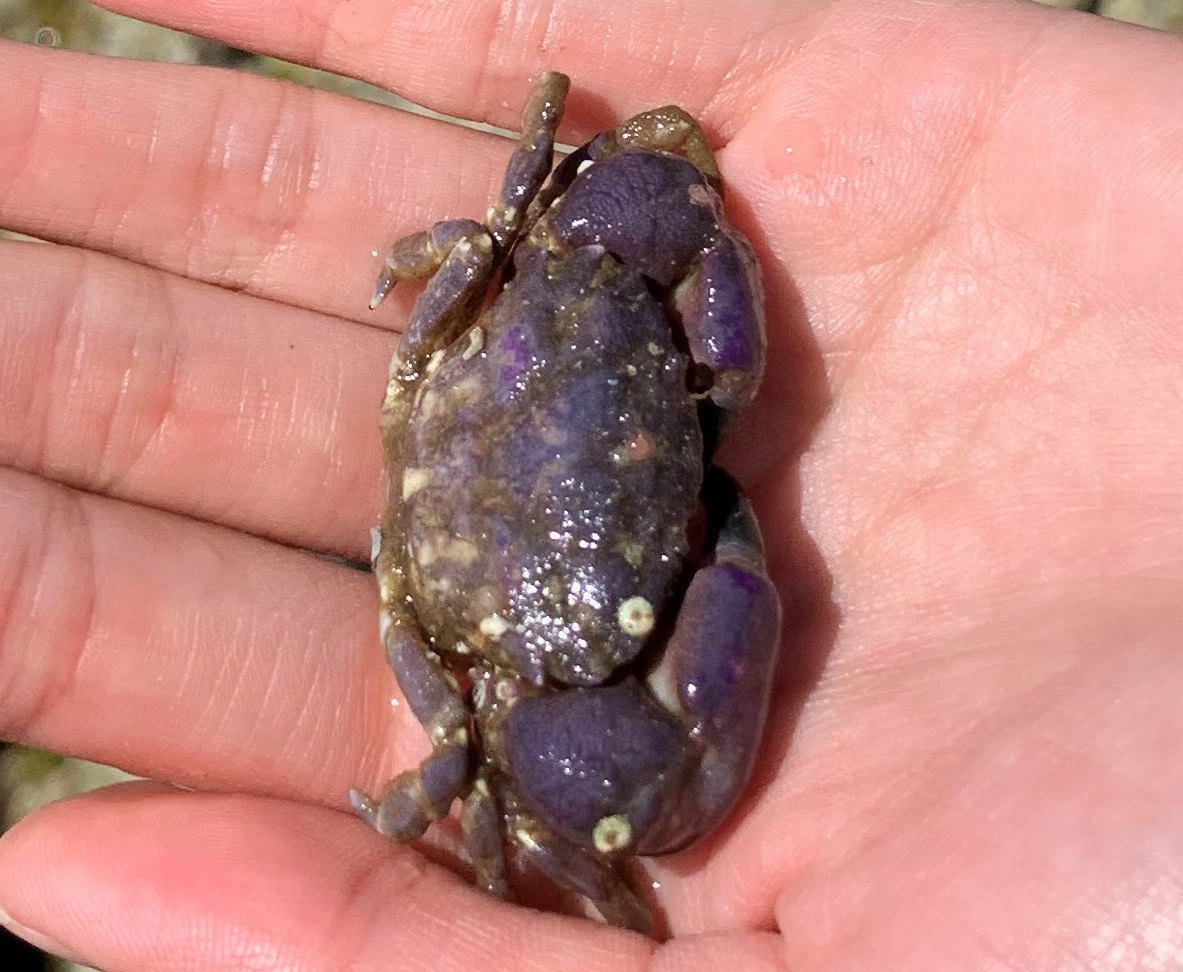Lophopanopeus bellus subspecies bellus (Stimpson, 1860)Common name(s): Black-clawed crab, Black-clawed pebble crab, Northern black-clawed crab |
|
| Synonyms: Xantheo bella, Lophoxanthus bellus | |
| Phylum Arthropoda
Subphylum Crustacea Class Malacostraca Subclass Eumalacostraca Superorder Eucarida Order Decapoda Suborder Pleocyemata Infraorder Brachyura Section Brachyrhyncha Family Panopeidae |
|
| Lophopanopeus bellus bellus from Swirl Rocks. Carapace width approximately 3 cm. | |
| (Photo by: Dave Cowles, July 2000) | |
How to Distinguish from Similar Species: Lophopanopeus bellus subspecies diegensis is subtidal in our area and has prominent tubercles on the carpus of the chelopeds, whereas subspecies bellus has a smooth carpus. The cancrid crab Cancer oregonensis is of similar size and carapace shape, hides under rocks, and has black claw tips but the Cancer crabs have a more truly oval carapace and have 5 teeth between the eyes.
Geographical Range: Aleutian Islands, Alaska to San Luis Obispo County, CA; rare in southern part of the range.
Depth Range: Intertidal to 80 m
Habitat: Under rocks, especially on gravel, both in protected waters and on the open coast; and on kelp holdfasts.
Biology/Natural History: This species is onmivorous, and feeds on algae, small mollusks, and barnacles. Sometimes captured individuals extend and lock their claws when handled. Eggs are carried beginning in March and hatch from May to August in British Columbia. Many females produce 2 broods per year, with 6,000 to 36,000 eggs per brood. May be parisitized by a Rhizocephalan Sacculinid barnacle (At Sitka, Alaska perhaps 25% of the crabs are parasitized). I have not found this high a percent parasitism in the Puget Sound area. Fossils of this species have been found in Pleistocene deposits in Playa del Rey, southern California. This species has 124 chromosomes (62 pairs).
| Return to: | |||
| Main Page | Alphabetic Index | Systematic Index | Glossary |
References:
Dichotomous Keys:Coffin, 1952
Flora and Fairbanks, 1966
Hart, 1982
Kozloff 1987, 1996
Smith and Carlton, 1975
Wicksten, 2009
General References:
Brown
and Rovetta, 1996
Harbo,
1999
Hinton,
1987
Jensen,
1995
Kozloff,
1993
McConnaughey
and McConnaughey, 1986
Morris
et al., 1980
Niesen,
1994
Niesen,
1997
O'Clair
and O'Clair, 1998
Ricketts
et al., 1985
Sept,
1999
Scientific Articles:
Burnett, Nicole, 2024: A practical identification guide to the zoeae of the invasive European green crab, Carcinus maenas (Linnaeus, 1758) (Decapoda: Brachyura: Carcinidae), and to the zoeae of the families of brachyuran crabs in Washington state, USA. Journal of Crustacean Biology 44:4. doi.org/10.1093/jcbiol/ruae064
General Notes and Observations: Locations, abundances, unusual behaviors:

View of the egg mass of a berried female. The numerous eggs of this species are so small and so dirty-looking that they can be mistaken for the Rhizocephalan Sacculinid barnacle identified as Loxothylacus panopaei, which when sexually mature erupts from the abdomen. Observe carefully to see whether the crab is actually parasitized or simply carrying a dirty-looking egg mass. Photo by Dave Cowles
Note: More recent references seem to indicate that Loxothylacus panopaei is not found in the Pacific, so the parasitized crabs in California and Alaska must be parasitized by a different barnacle.
The carapace of this crab can be purple, as in this individual photographed at Orcas Island by Alexandra Tyler in July 2021:

Authors and Editors of Page:
Dave Cowles (2005): Created original page